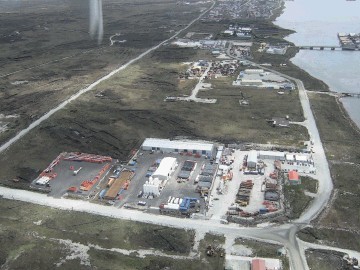
Utterly crucial to the success of the current Falklands campaign is the supply chain. At more than 8,000 miles from Aberdeen to Port Stanley it presents a huge challenge, yet it is one that has been successfully overcome.
At the Falklands end, the core component is the Byron & McKay Port Services supply base. This is a 50:50 JV between Byron Marine and Neil McKay Services,
And the driving force behind the venture in Falklands terms is the entrepreneurial Lewis Clifton, who is a semi-regular visitor to Aberdeen.
One way and another, he has participated throughout the entire gestation of the Falklands oil hunt to date, which symbolically started in 1995 when the UK Government passed legislation in 1995 that enabled the Falkland Islands Government to go out to seek open bids from companies for acreage offshore Falklands.
Recounting the first drilling campaign of 1998, he said that following its termination it was really only Argos and Desire, and especially the latter that kept the flame of hope burning, that one day a rig would return to the Falklands to drill for and find oil.
That flame was fanned eagerly by the then director of mineral resources for the Falklands, Phil Rendall working with British Geological Survey, Their sales pitch was armed with samples taken during the first campaign as it demonstrated world-class source rock.
“Mid-year 2009 … Desire announced that it had secures the rig Ocean Guardian from Diamond Drilling and that drilling would get under way in the Falklands within a six months period,” says Clifton.
“The rig was towed here by a very new Maersk vessel, the Maersk Traveller. As a consequence of that move by Desire, then Rockhopper came into the frame. RKH drilled and they were hugely successful. Finding Sea Lion was one in a million, some folks would say.”
Keeping Ocean Guardian and currently Leiv Eiriksson reliably supplied has been and remains of critical importance.
“There was huge risk, but the only sensible, practical way to support the Falklands was to do it out of Aberdeen because any involvement or linkages into South America would have had the Argentines ranting. The umbilical cord had to be Aberdeen to the Falklands,” says Clifton.
“Straight line all the way … 6,000-7,000 tonnes of kit at a time … offloaded at the supply base and kept there and topped up as necessary.
“There was a requirement to establish a supply base in the Falklands that could support offshore operations. For a number of years I was working for Desire. And in an earlier period, about 2006, Desire was going drill, except that the price of rigs went wickedly wild over a few weeks and the company had to pull out. I had already done a bit of footwork in the Falklands in terms of what would constitute a suitable supply base.
“In 2009, as soon as Desire made the announcement that it had a rig, my company (Byron Marine) committed to constructing some infrastructure; we committed with another Falklands company, Neil Mckay Ltd to create a joint venture to be able to bid for onshore logistics services. As a result, Byron Mackay Port Services has been supporting the offshore operation from Stanley from two supply bases since January 2010.”
And, in the event, the feeder service from Aberdeen worked very well, utilizing vessels from the Hansa Heavylift and BigLift fleets, plus units of Beluga Shipping as was.
Clifton says the Sea Lion discovery by Rockhopper is already proving a game changer for the Falklands.
Indeed the archipelag’s government has been enjoying what almost amount to windfall revenues because of the current oil and gas activity.
“Look at Byron. We’ve employed a small building team in Stanley since the beginning of 2009 and we still have them employed. We’re currently putting up a very large shed to provide for winter operation of cement cutting under cover.”
However, even in the tiny Falklands community (population around 3,000), Clifton’s business has faced competition.
“When it came to bidding for a package of works in the Falklands to support Desire’s well commitments, the company in turn appointed AGR Petroleum Services as its contractor.
AGR put out an invitation to tender and we bid for the provision of lay-down, warehousing, accommodation units, craneage, trucks, forklifts, personnel, all those things.
“Competition could have been quite severe.
“As I understand it there were two main players. One would have been the Falkland Islands Company, the other was Stanley Services.
“I believe there was outside interest too.”
However, Byron prevailed and Marine Services has held sway since 1996, supporting all offshore-related vessels active in Falklands waters.